The historical information found within the page of this website was taken from a special edition of the Alcona County Review published on July 25, 1968, to celebrate Greenbush’s 100th anniversary.
Additional information on the last 50 years was contributed through various sources such as newspaper, photos, etc. Every effort has been made to provide as accurate information as was available to the Sesquicentennial Committee for 2018.
1840
Sauk Indians were the first known inhabitants of the lower peninsula of Michigan and Canada. They were a war like tribe who were always at war with neighboring tribes. A council of war was called by Chippewas, the Ottawas, the Pttawatomies, the Menominees and six nations of New York.
Banding together, they wiped out the Sauks except for 12 families who were banished to the land of the Sioux across the Mississippi River. All this was more than 425 years ago.
Alcona County was named for a Chippewa chief who was a friend of the Americans in their fight with the British, ending in the war of 1812. He was a six-foot brave chief named Negwegon, which means Little Wing. The Michigan Act of Legislature gave it this name when the county was laid out on April 1, 1840.
Greenbush was one of the three original townships, along with Alcona and Harrisville, when Alcona was organized as a county in 1840.
1843
However, an Indian Agent named Henry R. Schoolcraft, changed the name to Alcona, de- rived from his own formula: “Al,” Arabic for “the,” “co,” root of the word meaning “plain” or “prairie,” and “na” meaning “fine” or “excellent.” Put all together, Alcona means “The Fine Plain.” In 1843, the legislature changed the name of the County to Alcona. Alcona County became the alphabetical first of 83 counties in the state of Michigan.
1854
By 1854 land hunters were coming to the Greenbush area to be one of the first to locate government pine land in this area. Land could be purchased for $1 to $1.25 an acre. Morris & McDougal of New York were the first men to buy government pine land. McDougal set up his lumbering camp where the Greenbush Golf course is now located.
1862
When Mr. McDougal bought thousands of acres of pine in 1862 and set up a lumbering operation and camps along the bluff where the Greenbush Golf Course now lies, this area became known as McDougal’s Landing.
1865
In 1865, a landmark of Greenbush originated when an old Country Store came into being. The Conklin Company patronized loggers and their families, offering items not only food but wearing apparel, hardware, drugs and may other items of need in those days.
1867
Around 1867 other lumbering companies were operating in the area and the name changed from McDougal’s Landing to Greenbush. It seems there was a very homesick young man from Greenbush, Rensselaer County, New York and to make him feel more at home the name was changed to Greenbush.
William Conklin came from New York State about 1867 and established the first saw mill in the area. He built a large stable to house his 60 horses.
1869
In 1869 Christina and Duncan Bruce with their six children arrived in Greenbush by boat. Their son, Daniel, laid out the first road going from Greenbush to the Pine River. The family settled in Mikado.
Some of the other old settlers included Patrick McArthur, Michael McCambridge, George McTammany, John and Ducan McGillis, George Stevens, Colin Campbell, Wellington Ruse, Donald McCall, Andrew Fraser, John Reynolds, Robert Stewart, Duncan McRae, Daniel McDermaid, John McKinnon and several McDonald families.
The “Company Boarding House” stood on the brow of the hill. At this time there were at least 1500 people living in and within a mile of Greenbush. Sixty pupils attended the school.
By 1868 the lumbering and fishing industry brought a number of families to the area to live so in 1869 a school was established and the first teacher was Miss Libby Wally.
1870
With the growth of the lumbering business, it soon became apparent that more and more families were coming to the area, and more and more children would be here, and they would need a school.
So, in 1870 a little schoolhouse was built. At the beginning enrollment consisted of 25 pupils, and the first teacher was Libby Wally. The Greenbush School was moved across Campbell Street in 1979. It is the oldest school building remaining in Alcona County.
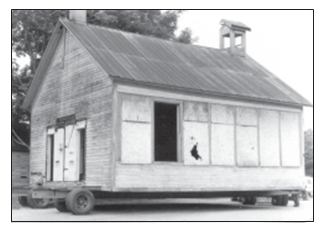
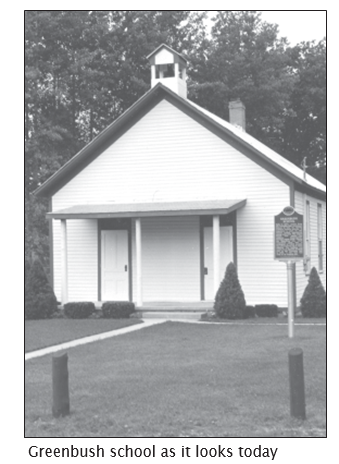
1879
Fire was an enemy of the Alcona County settlers. In June 1879, fire struck. The following was taken from the Alcona County Review, June 6, 1879.
Last Friday there was great excitement in numerous portions of Alcona County, caused by raging fires in the woods and swamps. Harrisville was hard hit, and at Greenbush about five thousand feet of timber and logs, belonging to F.M. Fowler were burned on the skidways, and also a large amount of standing timber was damaged. The flames held sway for a long time about Greenbush, and there was a manifest fear on the part of the citizens that the fires from the west would communicate with the buildings, but providentially a heavy rain came Saturday night, put out the fires and left all hearts at ease again. It is impossible to estimate the amount of damage done in the county by these late fires. Some of the farmers had their fields of grain and potatoes burned out and completely destroyed. Everything was as dry as tinder and in many places the very earth seemed to burn like wood.”
1900
In 1900 Duncan McRae purchased hundreds of acres of wooded land south and west of Greenbush which consisted of the VanBuskirk property, the General Store, and the land between the lake from the Greenbush-Mikado Road to the lakeside property.
The Country Store had new owners in Mr. VanBuskirk and Duncan McRae in 1900. During this time, the post office was part of the General Store and continued to be housed there for some time.
1904
Greenbush did not have a church for many years, so services were held in the Schoolhouse. Leadership was under the Methodist conference and ministers were sent to Greenbush each year. In those days the ministers were called circuit riders, because they traveled mostly on horseback and had several churches under their care. A real church was discussed, and due to the efforts of citizens at that time, a meeting was called with Rev. Rawlinson and officers of the church. It was voted to purchase the Black River Church, which had served well during the lumbering days. A plot of land was needed on which to rebuild the church and this was donated by Duncan McRae Sr., a pioneer resident of Greenbush.
He was appointed to go to Black River to purchase the building, have it torn down and the lumber and pews shipped to Greenbush. The church was dismantled and hauled with teams of horses and wagons. Duncan McRae gave $100 toward this project. The group had little money and all volunteer labor. In April 1904 the Greenbush M.E. Society purchased the building and had it moved to Greenbush. The church was rebuilt, and in 1904, the church was dedicated.
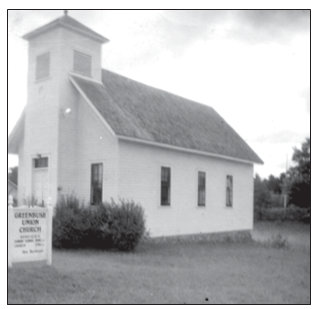
1905
In 1905 Carl E. Schmidt of Detroit purchased thousands of acres of land and miles along the Lake Huron shores. Mr. Schmidt was very interested in developing Greenbush and many families followed him from Detroit and built and bought homes in the village.
1910
In 1910 a man named James Bell came to Greenbush and purchased land along the high banks of the lake along with farms and farmland. He advertised for people to come and live on the farms, selling them property at “reasonable prices.” He changed the town name to “Perfection” This name didn’t last long as his wife’s relatives had it changed back to Greenbush.
1912
A Chicago firm considered digging and drilling for gravel in the Greenbush area. An excellent grade of gravel was discovered, and according to records found in the county building, land was purchased by the Huron Shore Gravel Co. for $423.
The Federal Land and Gravel Co. moved in and started to dig gravel. The first cook camp was built about 1912. Sadie Fraser McRae worked there as a young girl, as did some others in the village.
In 1912 Charles Schmidt purchased 40 acres from James Bell at the site of the first settlement of Crozier Davison’s fishery and cooperage of 1848. The plan for the property was to turn it into a park. Improvements to the area were started at once. On a drive through the area in September, he, Dr. Tobias Sigel, F.W. Clark and Charles Glaser were quoted in Joseph Labadie’s journal, “We discovered two springs, one on each side of the lake side approach to this beautiful park, so ornamental that we stood quietly for some time beholding this splendid gift of nature.” It was on this trip that it was officially named Alice’s Park after Mr. Schmidt’s wife, Alice Schmidt.
The park was located north of Greenbush between Lake Huron and Cedar Lake Road, on the north side of what we now know as F-30. Over the next several years various groups from Greenbush and Harrisville made use of the park as it was the show place of the area. The annual M.E. Sunday School picnic was held there in August of 1913. The park was used as late as 1937.
1919
In 1919 the Joseph Macks came from Detroit and became new owners of the Country Store. Facilities to service the automobiles were installed such as hand operated gas pumps. This family stayed with the store for about 6 years.
1922
In 1922 Fred and Flossie Wilcox moved from Evart, Michigan, where Fred was a plant manager. Fred took over the management in Greenbush for the Federal Gravel Co.. At that time most of the gravel was loaded by hand.
1925
In 1925, on June 22, the Greenbush Inn was officially established, owned by Carl E. Schmidt of Serradella Farm, and operated by manager Mr. Hans W. Boehme. Mr. and Mrs. Boehme and their daughters, Dorothy and Shirley, moved here from Detroit. The Inn, at the opening, consisted of three bedrooms, and a family size dining room. It was apparent from the number of guests patronizing the Inn that an addition was an immediate necessity.
In the latter part of 1925 the first addition was begun. The hotel was modernized with the addition of electric lights and running water. The office and lobby were connected with a comfortably furnished lounge which featured a large stone fireplace. The dining room, 42 by 32, seated 140 people. Seventeen guest rooms were added at this time and featured hot and cold running water.
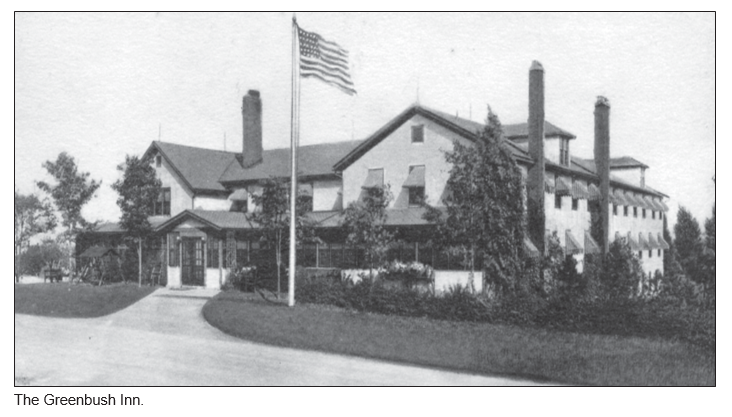
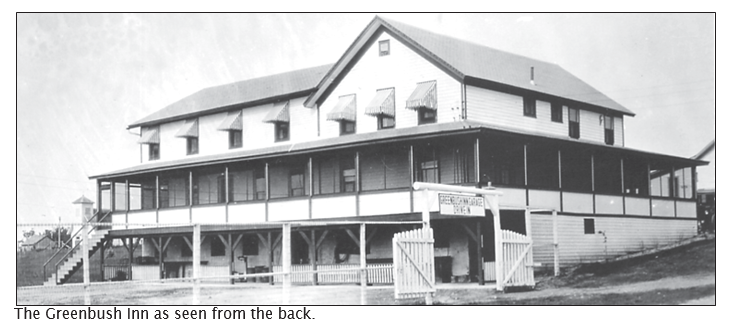
1926
In 1926, Annie and Hans Kunow with their son Karl, came from Detroit to operate the General Store (County Store), Post Office and newly added gas station. They were well liked and provided a pleasant and helpful addition to the friendly community of Greenbush. The Kunows continued to operate as a general store for 10 or more years, adding to their business a log cabin which housed several types of business.
1930
In 1930 the new shoreline drive was proposed and Mr. Carl E. Schmidt gave the right-of-way over all land bordering Lake Huron through which the highway would pass creating US 23. In 1937 Scenic Route US 23 to Alpena was completed.
1931
In 1931 Federal Gravel Company sent several steel tanks from Gary, Indiana, in which to store the gravel being mined in Greenbush. These tanks measured 21 feet x 40 feet and were shipped on flat cars.
1933
In 1933 when the Kunows converted their Country Store business into a Tavern, groceries were maintained in the nearby log building. The Tavern gained its friendly and old fashioned atmosphere through the efforts of Annie and Hans, which carried on through the remaining years of the Old Greenbush Tavern.

1945
In 1945 Annie and Hans found it necessary to retire and their remaining years were spent between Greenbush and Florida. The Greenbush Tavern was sold in 1945 to Alta and Raymond Casey.
1948
The Hechlik and Boyer families moved from Hamtramack in 1948 and purchased the Tavern from the Caseys. A fire destroyed the upstairs living quarters in 1949. Plans to build a new tavern soon were in process and in 1950 they moved into their beautiful new building located on US-23.
1952
The year 1952 will go down in Greenbush history as the beginning of great achievements. This is the year the planning of the fire department began.
1953
During January and February of 1953 meetings were held by the fire committee to plan for a fire hall for a new truck. John Kowalski was designated as overseer of this project, and at the same meeting the board approved the appointments of the Greenbush Fire Department’s first officers: Frank Raynak, chief; William Schmidt, assistant chief; Harold Renico, captain; and Edward Hechlik, lieutenant. Ormand Reames was designated construction engineer with Stanley Sterling as assistant.
The fire committee then suggested that the fire hall structure be put up by volunteer labor. On Monday, May 18, 1953 the forms were set and the foundation was poured. Through the generosity of many business establishments, necessary supplies and materials were purchased at cost, and in many instances, donations were made.
Everyone in the township was aware when the fire engine arrived. There was great excitement all up and down US-23, Cedar Lake Road to the county line, out in the country, and in the village as the truck sounded its siren. Since the original equipment there has been continuous advancement to improve and sustain the gear for the safety and protection of the community and the firefighters. Responder program is still active today.
1968
The Greenbush Inn, a landmark in this area for over forty years, was completely destroyed by fire in the early hours of Sunday morning, May 19, 1968. The fire, of undetermined origin, was discovered shortly after midnight by a passing motorist who put in a call to the Greenbush Fire Department.
1979
Construction of a new fire hall began in 1979.
1990
Newcomers to Greenbush can certainly make a difference. Clark and Mary Eckles, new residents of the community, gave a most generous gift of $10,000 through the Herrick Foundation for the building of a gazebo. It was to be built on a historical site and now rests between the Township Hall and the Greenbush Schoolhouse. Mr. Eckles is the former manager of Tecumseh Products Company Division. At Mr. Eckles request, Kenneth Adair spearheaded the project which was completed in July of 1990.
The gazebo became a grand place for weddings and for decorating with lights during the holiday season.
1991
On October 1, 1991, a large crowd gathered in chilly autumn air at the pavilion of the Greenbush Recreation Area. The gathering was to honor and remember the man most responsible for bringing the dream of the township park development to life. The park was named after and dedicated to the honor and memory of Raymond E. Spencer, former President of Greenbush Chamber of Commerce.
The inception of the First Responder program in 1991 is credited to Alcona County Emergency Coordinator, Leroy Hall who taught the first class for First Responders.
2006
Saturday, May 27, 2006 the Greenbush Tavern burned down. There were five customers and four employees in the building and all escaped without injury.
